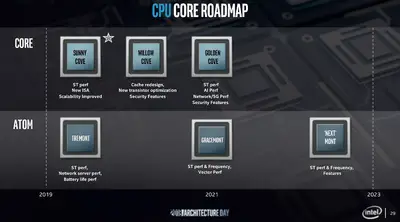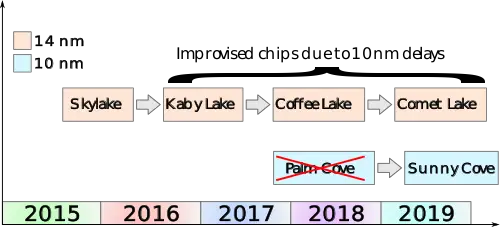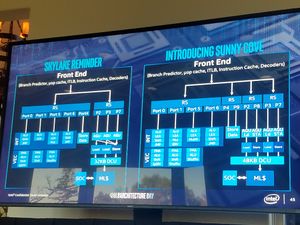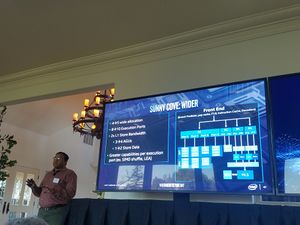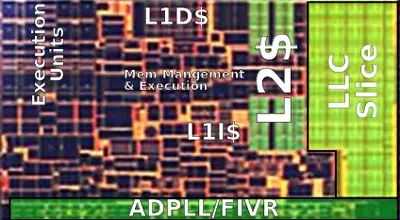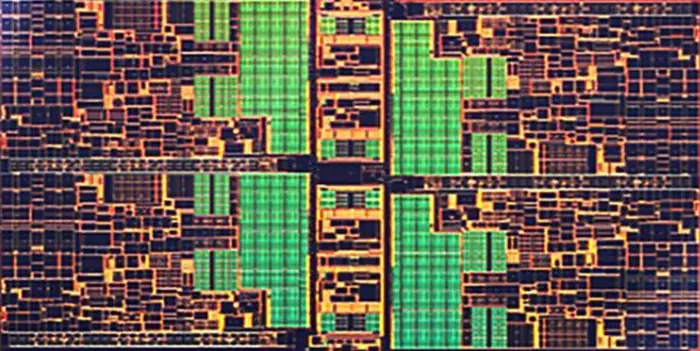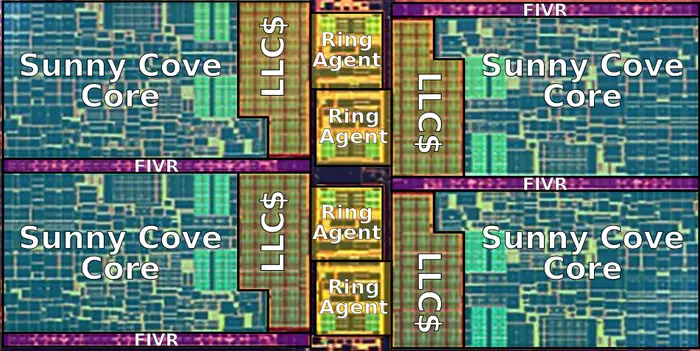| Edit Values | |
| Sunny Cove µarch | |
| General Info | |
| Arch Type | CPU |
| Designer | Intel |
| Manufacturer | Intel |
| Introduction | 2019 |
| Process | 10 nm |
| Core Configs | 2, 4 |
| Pipeline | |
| Type | Superscalar |
| OoOE | Yes |
| Speculative | Yes |
| Reg Renaming | Yes |
| Stages | 14-19 |
| Instructions | |
| ISA | x86-64 |
| Extensions | MOVBE, MMX, SSE, SSE2, SSE3, SSSE3, SSE4.1, SSE4.2, POPCNT, AVX, AVX2, AES, PCLMUL, FSGSBASE, RDRND, FMA3, F16C, BMI, BMI2, VT-x, VT-d, TXT, TSX, RDSEED, ADCX, PREFETCHW, CLFLUSHOPT, XSAVE, SGX, MPX, AVX-512 |
| Cache | |
| L1I Cache | 32 KiB/core 8-way set associative |
| L1D Cache | 48 KiB/core 12-way set associative |
| L2 Cache | 512 MiB/core 8-way set associative |
| L3 Cache | 2 MiB/core 16-way set associative |
| Succession | |
Sunny Cove is the successor to Palm Cove, a high-performance 10 nm x86 core microarchitecture designed by Intel for an array of server and client products, including Ice Lake (Client), Ice Lake (Server), Lakefield, and the Nervana NNP-I. The microarchitecture was developed by Intel's R&D Center (IDC) in Haifa, Israel.
Contents
History
Sunny Cove was originally unveiled by Intel at their 2018 architecture day. Intel originally intended for Sunny Cove to succeed Palm Cove in late 2017 which was it was intended to be the first 10 nm-based core and the proper successor to Skylake. Prolong delays and problems with their 10 nm process and resulted in a number of improvised derivatives of Skylake including Kaby Lake, Coffee Lake, and Comet Lake. For all practical purposes, Palm Cove has been skipped and Intel has gone directly to Sunny Cove. Sunny Cove is expected to debut in mid-2019.
Process Technology
Sunny Cove is designed to take advantage of Intel's 10 nm process.
Architecture
Key changes from Palm Cove/Skylake
- Front-end
- Larger µOP cache (?, up from 1536)
- Back-end
- Wider allocation (5-way, up from 4-way)
- Larger ROB (?, up from 224 entries)
- Scheduler
- Larger scheduler (?, up from 97 entries)
- Larger dispatch (10-way, up from 8-way)
- Execution ports rebalanced
- New store data port
- New store AGU port
- Memory subsystem
- LSU
- Deeper load queue (?, up from 72 entries)
- Deeper store queue (?, up from 42 entries)
- Larger L1 data cache (48 KiB, up from 32 KiB)
- Larger L2 cache (512 KiB, up from 256 KiB)
- Larger STLBs
- 5-Level Paging
- Large virtual address (57 bits, up from 48 bits)
- Significantly large virtual address space (128 PiB, up from 256 TiB)
- LSU
This list is incomplete; you can help by expanding it.
New instructions
Sunny Cove introduced a number of new instructions:
-
CLWB- Force cache line write-back without flush -
RDPID- Read Processor ID - Additional AVX-512 extensions:
-
AVX512VPOPCNTDQ- AVX-512 Vector Population Count Doubleword and Quadword -
AVX512VNNI- AVX-512 Vector Neural Network Instructions -
AVX512GFNI- AVX-512 Galois Field New Instructions -
AVX512VAES- AVX-512 Vector AES -
AVX512VBMI2- AVX-512 Vector Bit Manipulation, Version 2 -
AVX512BITALG- AVX-512 Bit Algorithms -
AVX512VPCLMULQDQ- AVX-512 Vector Vector Carry-less Multiply
-
-
SSE_GFNI- SSE-based Galois Field New Instructions -
AVX_GFNI- AVX-based Galois Field New Instructions - Split Lock Detection - detection and cause an exception for split locks
- Fast Short REP MOV
Overview
Sunny Cove is Intel's core microarchitecture for a series of client and server chips that succeed Palm Cove (and effectively the Skylake series of derivatives). Sunny Cove is just the core which is implemented in a numerous chips made by Intel including Lakefield, Ice Lake (Client), Ice Lake (Server), and the Nervana NNP accelerator. Sunny Cove introduces a large set of enhancements that significantly improves the performance of legacy code and new code through the extraction of parallelism as well as new features. Those include a significantly deep out-of-window pipeline, a wider execution back-end, higher load-store bandwidth, lower effective access latencies, and bigger caches.
Pipeline
| This section is empty; you can help add the missing info by editing this page. |
Die
Core
- 10nm+ process
- Core from an Ice Lake SoC
Core group
- 10nm+ process
- Quad-core from an Ice Lake SoC
Bibliography
- Intel Architecture Day 2018, December 11, 2018
| codename | Sunny Cove + |
| core count | 2 + and 4 + |
| designer | Intel + |
| first launched | 2019 + |
| full page name | intel/microarchitectures/sunny cove + |
| instance of | microarchitecture + |
| instruction set architecture | x86-64 + |
| manufacturer | Intel + |
| microarchitecture type | CPU + |
| name | Sunny Cove + |
| pipeline stages (max) | 19 + |
| pipeline stages (min) | 14 + |
| process | 10 nm (0.01 μm, 1.0e-5 mm) + |
